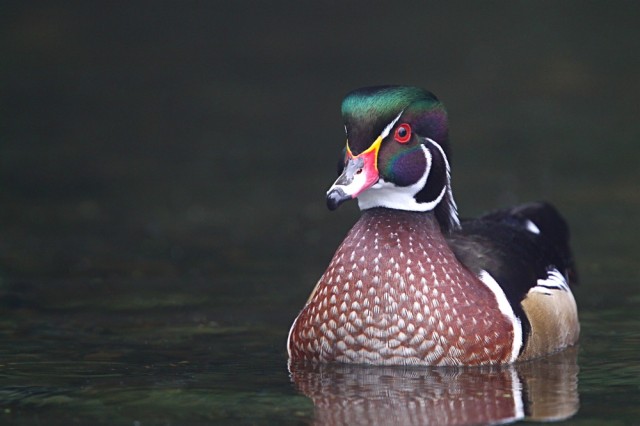Wood Duck
Status
Wood duck (Aix sponsa) is considered an uncommon yearlong resident in California, and primarily occurs in the Central Valley and along the Coast Ranges. This species is less common at higher elevations and in areas east of the Sierra and Cascade ranges. There have been some indications of a decline in nesting throughout California due to disturbance of riparian woodlands and predation by domestic animals on young. However, construction of nest boxes has allowed populations to increase in many locations.
Description
The wood duck is a small to medium-sized species of waterfowl that ranges in length from 15 to 21 inches. Male wood ducks (drakes) are dark and colorful with a glossy green head, slicked-back crest, contrasting white chin and throat, chestnut breast with speckled white spots, and dark back and hindquarters. The female is less colorful than the male and exhibits a more delicate, multi-colored plumage. Females are easily identified by the white “teardrop” around their eye, brownish-gray upperparts, mottled brown breast, and streaked, white pale belly.
Habitat Requirements
Wood ducks occur in freshwater ponds, marshes, lakes, and rivers, usually bordered by dense stands of trees or other tall vegetation. They often roost on quiet waters, including swamps, ponds, coves of lakes, flooded woodlands, and open water. Nesting typically occurs near or over water, in a tree cavity, a natural hole, or an old hole of a larger woodpecker or flicker. Nests are located between 3 to 60 feet above ground. Wood ducks also readily use suitable nest boxes and other artificial structures, with an approximate four inch diameter entrance hole. In California, wood ducks breed from April to August. Usually 8 to 10 eggs are laid and incubation occurs for 27 to 35 days. The young, which are tended by the female alone, first fly at 8 to 9 weeks, and occasionally become independent as early as 5 to 6 weeks.
Wood ducks glean the water’s surface and tip-up for aquatic vegetation. They are mainly herbivorous and feed on seeds, stems, and leaves of aquatic plants, seeds of trees and shrubs, waste grains, grasses, forbs and berries. Wood ducks are also known to eat some invertebrates and particularly acorns. They take food from the water’s surface, but also forage ashore, usually in woodland habitats or agricultural fields. Raccoons commonly prey on wood duck eggs and females sitting on eggs. Natural predators of ducklings include fish, snakes, and bullfrogs.
Local Occurrence
Wood ducks may use several preserves with wetlands and open water, but they are known to nest in boxes at the Silvergate preserve.

 (916) 434-2759
(916) 434-2759



